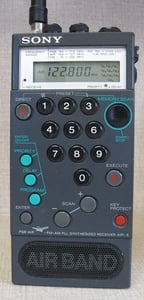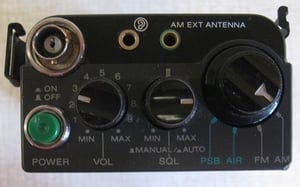Vintage Audio: Sony AIR-7 Aviation Band Synthesized Receiver | Telos Alliance
By The Telos Alliance Team on Dec 13, 2017 11:55:00 AM
 Vintage Audio: Sony AIR-7 Aviation Band Synthesized Receiver
Vintage Audio: Sony AIR-7 Aviation Band Synthesized Receiver
This Found in the Attic installment is an ‘80s flashback, even though it doesn't involve After the Fire, Blondie, or the Psychedelic Furs. Our subject is a 1985 Sony AIR-7, one of the earlier scanner receivers using frequency synthesis. From the name of this receiver, it's easy to surmise that it was designed to monitor the aviation bands, although it did quite a bit more.
In addition to the VHF aviation band of 108 to 136 Mhz, the AIR-7 also covered the FM broadcast band from 76 to 108 Mhz, the VHF public service band from 144 to 174 Mhz, and a large chunk of AM real estate from 150-2194 Khz. This included: LW frequencies from 150-530 Khz, which covered long-wave broadcast and radio navigation beacons; the standard MW broadcast band from 531 to 1602 Khz; and a small chunk of the short wave band from 1602 to 2194 Khz.
A switch on the back of AIR-7 permitted changing from the North American 10 Khz to European 9 Khz channel spacing. Sony also made a few different variants of the AIR-7 to accommodate European and Canadian aviation bands, which had different frequencies than American.
The most striking feature of this receiver is its cabinet styling. With its 6.5" x 3" x 2" case and flexible rubber-coated antenna, it looks like an '80s style walkie talkie, obviously to appeal to aviation enthusiasts. Presumably, it came with a carry strap and case when new.
The AIR-7 can be powered by four AA batteries, an external AC adapter, rechargeable battery pack, or car battery adaptor. The AC adaptor is a good idea for indoor listening, as this radio consumes batteries at an alarming rate. Published specs give an estimated life of 9 hours for an external pack with four C cells, and it's a good bit less for AAs.
Tuning of the AIR-7 is accomplished via a quartz-controlled PLL (Phase-Locked Loop) and a microprocessor. Stations may be selected by direct, scan, memory, or manual tuning. While today's scanners can store hundreds of frequencies in memory, this receiver can hold 40, ten for each band.
The front panel keypad can be a bit intimidating, and reading the instructions is really necessary. The simplest way to tune a single frequency is by pressing the direct key, entering the frequency, and then hitting enter. This frequency will be lost as soon as the power is turned off. If you don't know the frequency, press the SCAN+ or SCAN- keys to cruise up or down the band. By noting the frequencies as the AIR-7 scans, you can create a list of channels to later enter into memory. Manual tuning is accomplished by holding down the SCAN+ or SCAN- keys until the desired station is received.
hitting enter. This frequency will be lost as soon as the power is turned off. If you don't know the frequency, press the SCAN+ or SCAN- keys to cruise up or down the band. By noting the frequencies as the AIR-7 scans, you can create a list of channels to later enter into memory. Manual tuning is accomplished by holding down the SCAN+ or SCAN- keys until the desired station is received.
As a practical matter, it's best to store frequencies in memory. Once the desired station is tuned in, press ENTER along with one of the memory keys. A beep sounds and dot on the memory display indicates the station has been stored. Once that is done, you simply press the MEMORY SCAN button, and the AIR-7 scans from memory location 1 through 0. The PROGRAM function enables you to change the sequence of memory scanning, while PRIORITY checks a memory frequency for a signal every three seconds.
I keep a printout of frequencies and memory locations taped to the back of the receiver, as it has occasionally lost memory. It's likely there is an internal battery to hold up memory while the battery pack is removed, and that battery gave up decades ago.
There's usually a lot going on in the aviation band around airports, and a scanner is really necessary to keep track of it all. At small, non-towered airports, there is just one unicom frequency, where pilots communicate directly with one another to enable orderly and safe arrivals and departures. At larger airports, there are separate approach and departure frequencies, where pilots talk with air traffic control for takeoff and landing instructions. A separate ground control frequency is usually available, where aircraft are directed around the numerous taxiways to or from their hangar or terminal. Pre-recorded aeronautical information is available on the ATIS (Automatic Terminal Information Service) channel. Broadcasts include weather updates, active runways, available approaches, NOTAMs (Notices to Airmen), and other information required by pilots using the airport.
Several years ago, two Sony AIR-7s were discovered in an electronics recycling bin, buried under dozens of obsolete cell phones. They were in pretty rough shape. By cannibalizing one AIR-7, there was enough hardware, pushbuttons and other cosmetic parts to make a complete radio. Once it was powered up, it worked! If yours doesn't, the service manual is readily available as a free download on several web sites.
By today's standards, the AIR-7 is a dinosaur. People actually laughed when I brought it out to the local airport. Today, there are air band transceivers that are one-third the size of this 30-year old receiver. Laughter aside, it works well, and is often used to monitor the local unicom frequency as small aircraft take off and land at the nearby airport.
Further Reading
For other exciting vintage tech Found in the Attic, check out these recent installments:
Found in the Attic: Fly with an Edo-Aire ADF Receiver
Found in the Attic: Atwater Kent Model 84
Found in the Attic: PalmPilots m100 and m515
Telos Alliance has led the audio industry’s innovation in Broadcast Audio, Digital Mixing & Mastering, Audio Processors & Compression, Broadcast Mixing Consoles, Audio Interfaces, AoIP & VoIP for over three decades. The Telos Alliance family of products include Telos® Systems, Omnia® Audio, Axia® Audio, Linear Acoustic®, 25-Seven® Systems, Minnetonka™ Audio and Jünger Audio. Covering all ranges of Audio Applications for Radio & Television from Telos Infinity IP Intercom Systems, Jünger Audio AIXpressor Audio Processor, Omnia 11 Radio Processors, Axia Networked Quasar Broadcast Mixing Consoles and Linear Acoustic AMS Audio Quality Loudness Monitoring and 25-Seven TVC-15 Watermark Analyzer & Monitor. Telos Alliance offers audio solutions for any and every Radio, Television, Live Events, Podcast & Live Streaming Studio With Telos Alliance “Broadcast Without Limits.”
More Topics: Vintage Electronics
Recent Posts
Subscribe
If you love broadcast audio, you'll love Telos Alliance's newsletter. Get it delivered to your inbox by subscribing below!